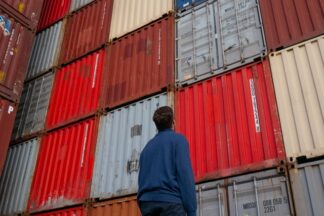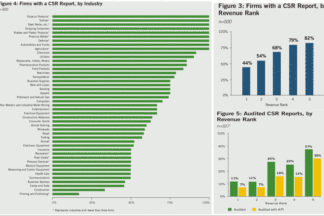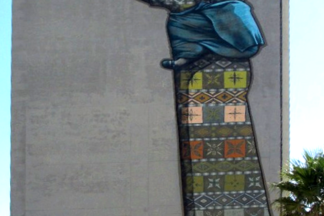This manual was originally drafted when I was astonished by the way how ‘doublespeak’ is being used in organisations to prevent change. Any change. Including – but not limited to – sustainability related ones.
It is a cynic-sarcastic-semi-realistic manual on how to be reasonably successful in disempowering an organisation. It is applicable to all areas that encompass change including innovation, sustainability, internationalisation, digitalisation and so forth.
This post is part of a series where I look at and into the true cost of certain goods and services. This time I’d like to look into the True Cost of all types Transport and Mobility: road, rail, aviation and water. The question therefore is: What are the total costs – the True Cost, i.e. including what is commonly called ‘externalities’ – of the different types of transport we use globally, both for passengers and for freight? Or if you prefer: how do different types of transport compare to each other when it comes to ‘collateral damage’?
Spoiler alert: It is really quite complex and rather diverse. And: public infrastructure investments and maintenance costs play a significant role in it.
This post is part of a series where I look at and into the true cost of certain goods and services. When in the previous post I looked at subsidies and the True Cost (associated with the True Price) for oil and gas, this time I’d like to look into what we know about the True Cost of Energy. Not just about fossil fuels, but indeed across the breadth of the energy spectrum.
The question therefore is: What are the total costs – the True Cost, i.e. including what is commonly called ‘externalities’ – of the
different types of energy we use globally?
Spoiler alert: It's very interesting - and also a bit suprising and counter-intuitive.
This is the first of a series that will look at and into true cost of certain goods and services. Cash subsidies thereby is one component, but certainly not the only one relevant one – indirect subsidies (e.g. in the form of environmental degradation or similar) need to be considered also. In this particular post, I’d like to focus on Oil & Gas subsidies, fossil fuels' True Cost, and what we know about these. What we already also learn: comparing apples to apples won't be easy.
True Cost calculations are only ever 'best available efforts', and much data remains missing or speculative at best. This is an issue we will encounter again also once we'll look into renewables, or indeed other kinds of industries outside of energy.
Reporting on ESG / sustainability dimensions is an issue.
One for the executives in a company across all levels of responsibility.
And one for the board.
For the board indeed even on two accounts, namely:
The metric they require to be reported to; and the metric that eventually find their way into publicly disclosed information of some shape or other.
Unsurprisingly: How seriously a company takes the ESG issue can be inferred from the extent, poignancy, and quality of their reporting.
That again – equally unsurprisingly – says is all about how ESG-savvy their board most likely is. Or, indeed, is not.
This post is going to be somewhat more personal than how I usually write. Normally, I try to write and argument as factually and data driven as possible. I’m not one that feels comfortable to carry my emotions on my sleeve. And even less as some of the topics I write about are truly important to me.
But: There are a couple of things that upset me in the present. They related to the #blacklivesmatter movement on the one hand, but maybe more specifically to the related discussion on #racism – globally.
-> Includes a list of practical resources for corporate boards
Have you heard about open data? And about open source?
The equivalent of open source in sustainability terms would be an ‘open standard’.
But what would that mean?
During the former Soviet Union, Ukraine developed as one of the largest centres of textile industry, representing approximately 50% of the entire SU's textile industry. And even after the SU fell to pieces, the Ukraine for quite some time remained with its manufacturing power. So, what is the status quo today?
Already early last year the Swedish Fast Fashion retailer H&M announced the placement of test orders for garments from Ethiopian and Kenyan suppliers. And they're not even the first ones: Retailers such as Tesco and Walmart seem to have gone down that lane already some time ago.
Traceability can be implemented at three different levels of stringency. Which level is implemented typically depends on the exact needs (technical, quality), legal and customer requirements – and last but not least also on the budget available.
Australia is a little bit like a big blank spot of knowledge as far as many of us here in Europe (and the US) are concerned.
The recently launched ‘Australian Fashion Report‘ is the first piece of work that looks very specifically at the sustainability and ethical trade practises of brands that are retailed in Australia, both local Australian as well as global brands.
This current post is looking at supply chain risk in the light of the Europe wide ‘Horse meat’ scandal. It remains to be said that the results found so far not only suggest that undeclared horse meat found its way into cheap and low quality, possibly prepared meals. But that there is a much more general, and widely spread problem with meats of different types ending undeclared on the shelves for consumption.
Supply chain transparency is – as it happens – among the prime concerns of investors when considering their risk. The news is though, that it really isn’t any news at all. Supply chain transparency has been called for for at least a couple of decades – for reasons that are entirely aligned with profitability, customer service, competitive advantage, product quality and so on and so forth.
In a recently published consumer study 52% percent of U.K., U.S. and Canadian consumers believe that businesses’ alignments with social...
On May 3rd 2012 the 2nd Fashion Summit took place in Copenhagen. Bringing fashion industry key people together to discuss sustainability with them, yet without using the term itself, is already a considerably achievement. Ilaria Pasquinelli attended and reports on her insights.
London Fashion Week 02/2011 - Day 2: EstEthica is successful so it seems. But what is there going on behind the scenes? Some controversial and critical insights.







